Far off into the Alps of Switzerland there exists a instrument workshop where Lukas Brunner dreams up designs for harp guitars that sound as crisp as the winter air with bass notes that dip down like the deep valleys below and with super treble strings that rise up like the mountain tops.

Nestled between Swiss mountain peaks is the small village of Lavin where harp guitarists seeking shelter from the winter snow will find a warm place to sit and pluck awhile at the Brunner Guitar shop.
-

-
Near the town center of Lavin
-

-
Brunner Workshop
-

-
Brunner Workshop Interior
In my travels in Europe I have managed to make a few visits to this magical world where savory chocolate, precision clocks and fine craftsmanship are the order of the day.

This is where I met Lukas Brunner who makes travel harp guitars that can be transported in a small bag, placed in an overhead or beneath the seat in front of you on an airline and can be assembled in a few seconds, for the most part in tune and ready to play a concert on!
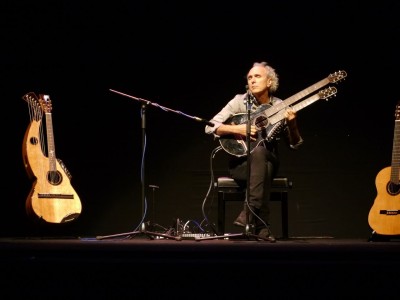
John Doan in Concert in Kuala Lumpur, Malaysia
After having the airlines loose my Elliott/Sullivan harp guitar three times (and fortunately also finding it three times!) it became a good idea to tour with a harp guitar that comes apart, fits in a small case and can always be with me on the road or in the air.

My good friend Philippe Fouquet and follow harp guitarist from France told me that he got a newly designed harp guitar from Lukas Brunner and raved about many improvements to this newest model and suggested that I look into getting one.

I put in an order this past year and I just received the latest model of Travel harp guitar from him this week. I am excited to share this instrument with you here and in my future concerts that I fly to.
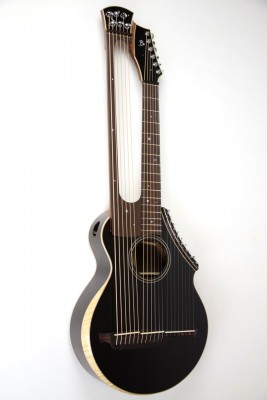
Brunner Travel Harp Guitar
It is stunning to behold. Lukas has such a remarkable eye for design and detail. Most notably his new design has the twenty strings centered on the body instead of running over to the treble side like my previous instrument. He achieves this with a single attachment for the guitar and bass string instead of two separate necks he used before. The black finish is exquisite and even dramatic. This took quite a bit of extra work to achieve.
This new instrument has an evenness of tone that prevails across the entire range. He has added internal bracing this time round that helps structurally and evens out the sound quality of the soundboard.

Brunner Travel Harp Guitar close up on face
There is a reverberant sound throughout and a great balance of the three pitch areas is achieved acoustically and not just by the use of a mixer.


Technically, the body dimensions are defined as B-medium: length: 19 1/8″ (48,6cm),
width: 14 1/2″ (36,8cm)
, depth: 4″ (10,2cm). The overall volume and vibrancy is somewhat less than the inch larger sound box of my Elliott/Sullivan harp guitar (that also has a hollow arm under the bass) but this new smaller sound box without the hollow arm still holds its own and is quite good to play acoustically.
The Indian rosewood used for the back and sides is really beautiful and the Red Cedar top is very lively.
The bass string lengths are 30 1/2″ (774mm) while the guitar string lengths are 25 1/2″ (650mm) (both standard on Brunner harp guitars).
Brunner uses Gotoh oval chrome tuners for the super treble strings that he places on a ledge (an early innovation he debuted on his previous model). On the bass shoulder bout can be found a sound port to give the player more sound to listen to while playing.
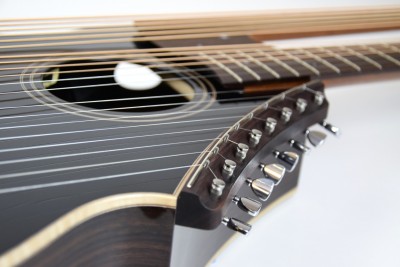
Brunner Harp Guitar from the Super Treble side revealing the upper sound port through the sound hole.
There were several details Lukas added to this instrument that were very brilliant like the bridge attachment not touching the face as well as being cut at an angle for a more sure fit.
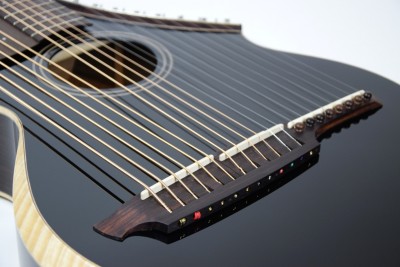
The beveled edge on the lower bass bout is beautifully done in curly Maple making it easy for the arm to rest while playing.

Brunner Harp Guitar from Bass side featuring curly Maple binding with beveled arm rest
I was looking for an overall appearance of the night sky and the beveled arm rest worked in visually as a crescent moon. I love how he managed to put the inlays of evening stars at harmonic points of the string, something easily overlooked when thinking of them as ornaments.

Brunner harp guitar close up of star inlays and side sound port

Brunner Harp Guitar headstock
The headstock is smartly designed with all the guitar tuner buttons off to the right and the bass tuners compactly set within the bass arm atop of a pillar to the far left. My previous travel harp guitar was considerably heavier with two full necks. The absence of the additional neck makes the instrument lighter and easier to work with.

Brunner Harp Guitar from the top down
All of these headstock tuners are locking tuners that only respond to adjustment while attached to the instrument and under pressure. This allows the tuning knobs to be knocked or turned while detached from the body without any impact on the tuning once the instrument is assembled (which only takes a few seconds to do!). What is remarkable and has guitarists gasping is that once the guitar and bass string attachment is snapped into place the instrument is virtually in tune!
The bass tuners are more like fine tuners and generally should work best if the basses are left at the same pitch from tune to tune. The lowest E goes easy enough up a half step to F as does the B down to Bb. I will be exploring using a lighter gauge string for the first sub bass so I can bring it up to E on occasion when I use a capo on the guitar. I hope that works as they are so snug and low profile, which is perfect for it being a travel instrument.

The magic behind the travel harp guitar is how the guitar and bass strings come off the body. That all starts by loosening the screw at the top of the sound box. Once loosened one very carefully presses down on the knob while holding down the neck so it comes up under control instead of quickly popping up. With a little practice this is a smooth transition.
-

-
Brunner Travel Harp Guitar Neck Detached
-

-
Brunner Harp Guitar Neck Socket
-

-
Brunner Travel Harp Guitar Detached
Brunner used good old Swiss precision tooling for the contact points that he originally worked out with his uncle who is a master tool smith. The precision allows for stability of the instrument once assembled and as above mentioned, contributes to the instrument being in tune when put back together.
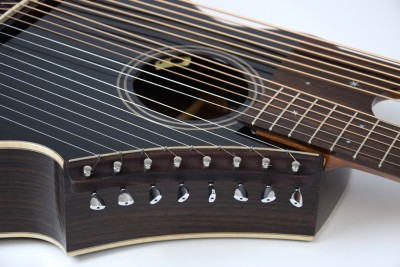
Brunner Travel Harp Guitar Close Up on Super Treble Strings
Once plugged in it sounds completely natural and will be a joy to play in concert thanks to the LR Baggs Anthem SL setup. As you look into the sound hole you can see a small dial that allows for adjusting the volume without reaching for a mixer or coordinating with the sound engineer.
In conclusion, there is so much that has gone into this newest model and I am thrilled with the results.
The overall length is shortened compared to his previous travel harp guitars which is great for travel. Brunner still managed to lengthen the super trebles a bit for a fuller tone and the sub basses still have good length to give a full tone as well.
As with his earlier model, the zero fret, the larger sound hole and the beveled arm rest work really great.
I have added a NeckUp Guitar Support for playing but it was great that I really didn’t have to have it given how the strings have been moved over to be centered on the face of the instrument.
I have a little bit of a learning curve to do to get use to the 16 fret neck versus the 21 fret of my Elliott/Sullivan harp guitar (the higher frets used mainly for indicators for locations of harmonics up the neck, but no big problem).
I am excited to bring it to your community for a future concert. This is truly a new year filled with hope and excitement for future music making.
(Special thanks to Lukas Brunner for all the fine photos of the new travel harp guitar).




























